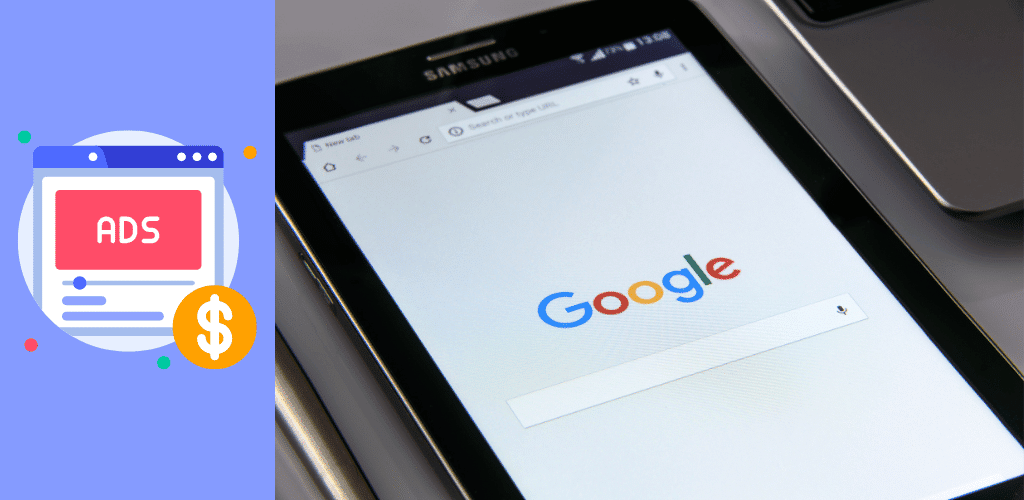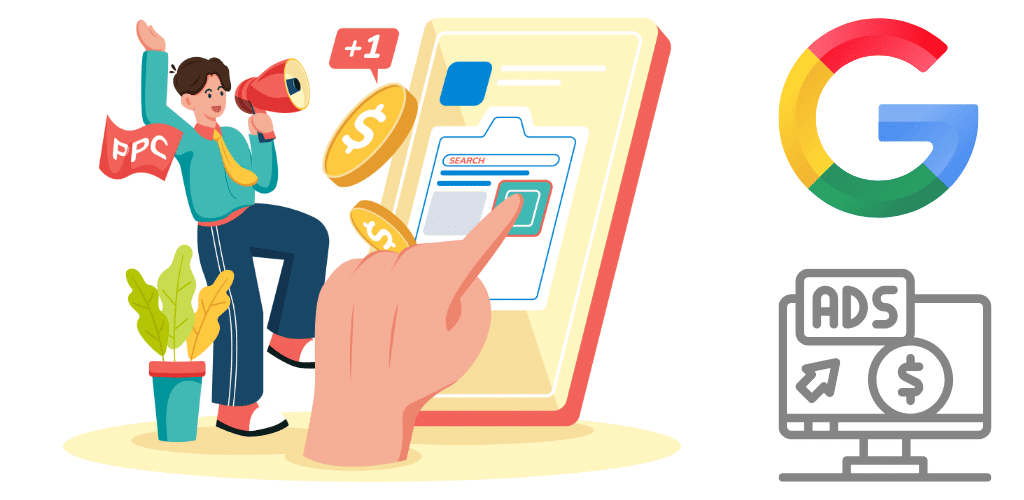Table of Contents
Introduction
Have you ever wondered why certain ads seem to follow you across the internet? You’re not imagining things – it’s the power of Google Display Advertising at work! In today’s digital landscape, capturing your audience’s attention is more challenging than ever. But what if there was a way to showcase your brand exactly where your potential customers are browsing?
Enter Google Display Advertising – your ticket to reaching over 90% of internet users worldwide. Imagine your ads appearing on millions of websites, in apps, and even on YouTube videos, all tailored to your target audience’s interests and behaviors.
Sounds too good to be true? It’s not! Whether you’re a small business owner looking to expand your reach or a marketing professional aiming to boost brand awareness, Google Display Advertising offers a powerful solution that can transform your digital marketing strategy.In this comprehensive guide, we’ll dive deep into the world of Google Display Advertising. You’ll discover its benefits, learn how the Google Display Network works, and explore the differences between display ads and search ads. We’ll also show you how to create eye-catching responsive display ads, share inspiring examples, and provide insider tips on budgeting and planning. Ready to take your advertising game to the next level? Let’s get started!
Benefits
Increased Brand Awareness
One of the primary benefits of Google display advertising is its ability to significantly boost your brand’s visibility. By showcasing your ads across millions of websites, apps, and Google-owned properties, you can reach a vast audience that may not be actively searching for your products or services. This increased exposure helps:
- Familiarize potential customers with your brand logo, colors, and messaging
- Keep your brand top-of-mind when users are ready to make a purchase
- Build trust and credibility through repeated exposure
Precise Targeting Options
Google’s display network offers unparalleled targeting capabilities, allowing you to reach the right audience at the right time. You can target your ads based on:
| Targeting Type | Description |
|---|---|
| Demographics | Age, gender, parental status, household income |
| Interests | Hobbies, passions, and lifestyle choices |
| In-market audiences | Users actively researching products or services |
| Custom intent audiences | People searching for specific keywords related to your business |
| Remarketing | Users who have previously interacted with your website or app |
This precise targeting ensures your ad spend is optimized for maximum impact and ROI.
Visual Appeal and Creativity
Display ads offer a unique opportunity to showcase your brand’s creativity and visual appeal. Unlike text-based search ads, display ads allow you to:
- Use eye-catching images and graphics
- Incorporate brand colors and logos
- Experiment with different ad formats (e.g., responsive ads, animated GIFs)
- Tell a visual story that resonates with your audience
This visual flexibility can lead to higher engagement rates and better brand recall.
Cost-Effective Advertising
Google display advertising often proves to be a cost-effective option for businesses of all sizes. Here’s why:
- Lower cost-per-click (CPC) compared to search ads
- Option to use cost-per-thousand-impressions (CPM) bidding for brand awareness campaigns
- Ability to set daily budgets and adjust bids in real-time
- Performance tracking tools to optimize your campaigns for better ROI
Remarketing Opportunities
One of the most powerful benefits of Google display advertising is the ability to remarket to users who have previously interacted with your website or app. This allows you to:
- Show tailored ads to users based on their past behavior
- Remind potential customers about products they viewed but didn’t purchase
- Upsell or cross-sell to existing customers
- Increase conversion rates by targeting warm leads
Measurable Results and Insights
With Google’s robust analytics and reporting tools, you can gain valuable insights into your display ad performance. This data-driven approach enables you to:
- Track impressions, clicks, and conversions
- Analyze user behavior and engagement metrics
- Identify which ad creatives and placements perform best
- Make data-informed decisions to optimize your campaigns
By leveraging these benefits, you can create highly effective display advertising campaigns that drive brand awareness, engage your target audience, and ultimately boost your bottom line. As we move forward, let’s explore what exactly Google display advertising entails and how it differs from other forms of online advertising.
What is Google Display Advertising?

Understanding Google Display Advertising
Google Display Advertising is a powerful digital marketing tool that allows you to showcase your ads across millions of websites, apps, and platforms within the Google Display Network.
This form of advertising goes beyond traditional text-based search ads, enabling you to reach potential customers with visually appealing banners, images, and interactive elements.
Key Components of Google Display Advertising
1. Visual Appeal: Unlike text-based search ads, display ads leverage eye-catching graphics, images, and videos to capture users’ attention.
2. Broad Reach: Your ads can appear on a vast network of websites, reaching users even when they’re not actively searching for your products or services.
3. Targeting Options: Google Display Advertising offers sophisticated targeting capabilities, allowing you to reach specific audiences based on demographics, interests, and behaviors.
4. Flexibility: You can choose from various ad formats, including responsive display ads that automatically adjust to fit available ad spaces.
How Google Display Advertising Works
1. Ad Creation: You design your display ads or use Google’s responsive display ad format.
2. Targeting Setup: You define your target audience and set parameters for ad placement.
3. Bidding: You set your budget and bidding strategy.
4. Ad Serving: Google’s algorithms match your ads with relevant websites and apps.
5. User Interaction: Users see your ads while browsing content across the Google Display Network.
Advantages of Google Display Advertising
| Advantage | Description |
|---|---|
| Brand Awareness | Increases visibility across a wide range of websites |
| Visual Impact | Allows for creative, eye-catching designs |
| Precise Targeting | Reaches specific audiences based on various factors |
| Remarketing | Re-engages users who have previously interacted with your brand |
| Cost-Effective | Often offers lower cost-per-click compared to search ads |
Types of Google Display Ads
- Responsive Display Ads
- Image Ads
- Video Ads
- Rich Media Ads
- Gmail Ads
By leveraging Google Display Advertising, you can expand your online presence, reach new audiences, and drive brand awareness in ways that traditional search advertising cannot match. With its vast network and advanced targeting options, display advertising offers a powerful tool for businesses of all sizes to connect with potential customers across the web.
Now that you understand what Google Display Advertising is and how it works, let’s explore the intricacies of the Google Display Network and how it can benefit your advertising campaigns.
How the Google Display Network Works

The Google Display Network (GDN) is a vast ecosystem of websites, apps, and digital platforms where your ads can appear. Understanding how it works is crucial for maximizing the effectiveness of your google display advertising campaigns.
The GDN operates on a programmatic advertising model, which means that ad placements are determined automatically based on various factors. These factors include:
- Targeting options
- Ad quality and relevance
- Bid amount
- Website context
Let’s break down each of these elements:
| Factor | Description |
|---|---|
| Targeting options | Audience demographics, interests, behaviors, and browsing history |
| Ad quality and relevance | How well your ad matches the user’s intent and the website’s content |
| Bid amount | The maximum you’re willing to pay for ad placement |
| Website context | The content and theme of the website where your ad may appear |
When you set up a display campaign, you’re essentially telling Google who you want to reach and how much you’re willing to pay. The system then works to place your ads in front of the right people at the right time across millions of websites and apps.
Here’s a simplified process of how your ad gets shown:
- A user visits a website that’s part of the Google Display Network
- Google’s algorithm analyzes the user’s profile and the website’s content
- If your targeting criteria match the user and your bid is competitive, your ad is eligible to be shown
- If your ad wins the auction, it appears on the website
Optimize your campaign as you create it
To make the most of the Google Display Network, you need to optimize your campaign from the start. Here are some key strategies:
- Refine your targeting: Use a combination of demographic, interest-based, and contextual targeting to reach your ideal audience. For example, if you’re selling fitness equipment, you might target health-conscious adults who frequently visit sports and wellness websites.
- Create compelling ads: Design visually appealing and relevant ads that stand out. Responsive display ads are particularly effective as they automatically adjust to fit available ad spaces.
- Set appropriate bids: Start with a conservative budget and adjust your bids based on performance data. You can use automated bidding strategies like Target CPA or Maximize Conversions to optimize your spending.
- Use exclusions: Prevent your ads from appearing on irrelevant or inappropriate websites by using placement exclusions and category exclusions.
- Monitor and adjust: Regularly review your campaign’s performance metrics and make data-driven decisions to improve its effectiveness.
By understanding how the Google Display Network operates and implementing these optimization strategies, you’ll be well-equipped to create successful display advertising campaigns that reach your target audience effectively and drive results for your business.
Responsive Display Ads

How Ad Creation and Optimization Works
Responsive display ads revolutionize the way you create and optimize your Google display advertising campaigns. With this innovative format, you can streamline your ad creation process and maximize your reach across the Google Display Network. Here’s how it works:
- Asset submission: You provide various assets such as headlines, descriptions, images, and logos.
- Automatic ad generation: Google’s AI combines these assets to create multiple ad variations.
- Real-time optimization: The system continuously tests different combinations to determine the best-performing ads.
- Adaptive sizing: Ads automatically adjust to fit available ad spaces across websites and apps.
This process not only saves you time but also ensures your ads are optimized for performance across different placements and devices. Let’s dive deeper into each step:
Asset submission
To create responsive display ads, you’ll need to provide the following assets:
- Headlines (up to 5)
- Long headlines (up to 1)
- Descriptions (up to 5)
- Business name
- Logo images (up to 5)
- Marketing images (up to 15)
- Videos (optional, up to 5)
| Asset Type | Quantity | Purpose |
|---|---|---|
| Headlines | 5 | Grab attention with concise messaging |
| Descriptions | 5 | Provide more details about your offer |
| Images | 15 | Visually represent your product or service |
| Logo | 5 | Reinforce brand identity |
| Videos | 5 | Engage users with rich media content |
By providing a variety of assets, you give Google’s AI more options to work with, increasing the chances of creating highly effective ad combinations.
Other Display Ad Types
While responsive display ads are the most versatile and recommended format, Google offers other display ad types to suit various advertising needs:
- Image ads: Static images in standard sizes that you design and upload.
- Video ads: Engaging video content displayed on YouTube and across the Display Network.
- Gmail ads: Interactive ads that appear at the top of users’ Gmail inboxes.
- App promotion ads: Specifically designed to drive app installs or in-app actions.
Each of these ad types has its strengths and can be effective depending on your campaign goals. Here’s a comparison of their key features:
| Ad Type | Visual Impact | Customization | Targeting Options | Best For |
|---|---|---|---|---|
| Responsive Display | High | Automated | Extensive | Versatile campaigns |
| Image | Medium | Full control | Standard | Brand awareness |
| Video | Very High | Full control | Advanced | Engagement |
| Gmail | High | Moderate | Gmail users | Direct response |
| App Promotion | Medium | Moderate | App users | App installs |
When choosing between these ad types, consider your campaign objectives, target audience, and available resources. Responsive display ads offer the most flexibility and are generally recommended for most advertisers due to their ability to adapt to various placements and optimize performance automatically.
Now that you understand how responsive display ads work and the other options available, let’s explore when and where these display ads typically show up in the Google Display Network.
Google Display Ads vs Search Ads

Key Differences
When it comes to Google advertising, you have two main options: display ads and search ads. Understanding the differences between these two can help you make informed decisions about your advertising strategy.
| Feature | Display Ads | Search Ads |
|---|---|---|
| Placement | Appear on websites, apps, and videos | Appear on search engine results pages |
| Format | Visual (images, banners, videos) | Text-based |
| User Intent | Passive browsing | Active searching |
| Targeting | Demographic, interests, behaviors | Keywords and search queries |
| Cost | Generally lower CPC | Often higher CPC |
| Brand Awareness | Excellent for building awareness | Better for capturing existing demand |
Audience Targeting
With display ads, you have the opportunity to reach a broader audience. You can target users based on their interests, demographics, and browsing behaviors. This approach allows you to introduce your brand to potential customers who might not be actively searching for your products or services.
Search ads, on the other hand, target users who are actively looking for specific products or services. When someone searches for a keyword related to your business, your ad can appear at the top of the search results, making it more likely to capture immediate interest.
Visual Appeal vs. Textual Relevance
Display ads give you the creative freedom to showcase your brand visually. You can use eye-catching images, engaging videos, or interactive banners to grab attention. This visual appeal is particularly effective for products that benefit from visual representation.
Search ads rely on the power of words. Your ad copy needs to be concise, relevant, and compelling to stand out among other text-based results. While less visually striking, search ads can be highly effective when matched with the right keywords and intent.
Performance Metrics
When comparing performance, you’ll notice some key differences:
- Click-through rates (CTR): Search ads typically have higher CTRs because they’re shown to users actively searching for related products or services.
- Conversion rates: Search ads often lead to higher conversion rates due to the user’s intent to find a specific solution.
- Cost per click (CPC): Display ads generally have lower CPCs, allowing for broader reach with the same budget.
Campaign Objectives
Your choice between display and search ads should align with your campaign objectives:
- Brand awareness: Display ads excel at increasing visibility and recognition.
- Lead generation: Search ads are often more effective for capturing leads from users ready to take action.
- Remarketing: Display ads are powerful for re-engaging users who have previously interacted with your brand.
- Immediate sales: Search ads can drive quick conversions for users with high purchase intent.
Now that you understand the key differences between Google display ads and search ads, you’re better equipped to choose the right approach for your advertising goals. Consider combining both strategies for a comprehensive digital marketing campaign that covers all stages of the customer journey.
What are display advertising examples?

Types of Display Advertising
Display advertising comes in various formats, each designed to capture your audience’s attention in unique ways. Here are some common examples you might encounter:
Banner Ads
Banner ads are perhaps the most recognizable form of display advertising. These rectangular images appear at the top, bottom, or sides of web pages. You’ll often see them in different sizes, such as leaderboards (728×90 pixels) or skyscrapers (160×600 pixels).
Rich Media Ads
Rich media ads take interactivity to the next level. These ads can include video, audio, or other elements that engage users. For instance, you might see an expandable ad that grows larger when you hover over it, revealing more information or interactive features.
Video Ads
Video ads have become increasingly popular with the rise of platforms like YouTube. These can appear before, during, or after video content, offering a dynamic way to showcase your products or services.
Native Ads
Native advertising blends seamlessly with the content of the website it’s placed on. You might encounter these ads in social media feeds or as “recommended content” at the bottom of articles, making them less intrusive and more likely to be engaged with.
Effective Display Advertising Strategies
To make the most of your display advertising efforts, consider these strategies:
- Visual appeal: Use high-quality images and compelling design to grab attention.
- Clear call-to-action: Guide your audience on what to do next.
- Relevance: Ensure your ad content matches the interests of your target audience.
- A/B testing: Experiment with different designs and messages to optimize performance.
Display Ad Formats and Their Uses
| Ad Format | Best Used For | Key Advantage |
|---|---|---|
| Banner Ads | Brand awareness | Wide reach and recognition |
| Rich Media | Engagement | Interactive elements increase user involvement |
| Video Ads | Product demonstrations | Visual storytelling capabilities |
| Native Ads | Content marketing | Seamless integration with site content |
Now that you’re familiar with various display advertising examples, you’ll be better equipped to recognize and create effective ads for your campaigns. Remember, the key to successful display advertising lies in understanding your audience and choosing the right format to convey your message effectively.
As you consider implementing these display advertising examples in your marketing strategy, it’s crucial to understand how they fit into the broader context of Google’s advertising ecosystem. Next, we’ll explore when these display ads typically show, helping you optimize your ad placement and timing for maximum impact.
When Display Ads Show

Google Display ads can appear in various places across the web, reaching potential customers at different stages of their buying journey. Understanding when and where these ads show up is crucial for maximizing your advertising efforts.
Placement Types
Display ads can appear in several locations:
- Websites: Ads show on Google’s network of partner websites
- Mobile apps: In-app advertising reaches users on their smartphones and tablets
- YouTube videos: Pre-roll, mid-roll, and banner ads on the popular video platform
- Gmail: Ads can appear in the Promotions and Social tabs of users’ inboxes
Here’s a breakdown of the most common placement types and their characteristics:
| Placement Type | Reach | User Intent | Ad Formats |
|---|---|---|---|
| Websites | High | Varies | Image, text, responsive |
| Mobile apps | High | Active engagement | Banner, interstitial |
| YouTube | Very high | Entertainment, information | Video, banner |
| Gmail | Moderate | Communication | Expandable ads |
How Performance Data Works
Performance data is crucial for understanding the effectiveness of your display ads. Google provides detailed metrics to help you analyze and optimize your campaigns.
Key Metrics to Monitor
- Impressions: The number of times your ad is shown
- Clicks: How many times users click on your ad
- Click-through rate (CTR): The percentage of impressions that result in clicks
- Conversions: Desired actions taken by users after clicking your ad
- Cost per click (CPC): The average amount you pay for each click
- Return on ad spend (ROAS): The revenue generated compared to your ad spend
To make the most of your performance data:
- Regularly review these metrics to identify trends and areas for improvement
- Use A/B testing to compare different ad variations and optimize performance
- Set up conversion tracking to measure the impact of your ads on your business goals
Remember, the Google Display Network uses machine learning to optimize ad placements based on your campaign objectives and historical performance data. This means that over time, your ads will be shown more frequently in locations where they’re likely to perform well.
As you analyze your performance data, consider the following factors that can influence when and where your display ads show:
- Targeting options: Your chosen audience segments, interests, and demographics
- Budget and bidding strategy: Higher bids can increase your ad’s visibility
- Ad quality and relevance: Better ads are more likely to be shown frequently
- Competition: Other advertisers targeting the same audience or placements
- Time of day and day of week: User behavior patterns can affect ad performance
By understanding these factors and leveraging your performance data, you can refine your display advertising strategy and achieve better results. In the next section, we’ll explore how much Google typically spends on advertising and how this relates to your own campaign budgets.
How Much Does Google Spend On Advertising?

Google’s Advertising Expenditure
Google, as one of the world’s largest tech companies, invests significantly in advertising to maintain its market position and promote its various products and services.
While the exact figures can fluctuate year to year, Google’s advertising spend is substantial and reflects its commitment to growth and market dominance.
Annual Advertising Budget
Google’s annual advertising budget typically ranges in the billions of dollars. In recent years, the company has been known to spend anywhere from $5 billion to $7 billion annually on advertising and promotional activities.
This substantial investment demonstrates the importance Google places on maintaining its brand visibility and expanding its user base.
Breakdown of Advertising Spend
Google’s advertising expenditure can be broken down into various categories:
- Traditional Media
- Digital Advertising
- Product-Specific Campaigns
- Brand Awareness Initiatives
Here’s a table illustrating a hypothetical breakdown of Google’s advertising spend:
| Category | Percentage of Budget | Estimated Amount |
|---|---|---|
| Digital Advertising | 45% | $2.7 billion |
| Traditional Media | 30% | $1.8 billion |
| Product-Specific Campaigns | 15% | $900 million |
| Brand Awareness Initiatives | 10% | $600 million |
Factors Influencing Google’s Ad Spend
Several factors contribute to Google’s advertising expenditure:
- Market competition
- New product launches
- Expanding into new markets
- Responding to industry trends
- Maintaining brand reputation
Comparison to Competitors
When you compare Google’s advertising spend to its competitors, you’ll find that it’s generally in line with other tech giants. Companies like Apple, Microsoft, and Amazon also invest heavily in advertising, with budgets often ranging from $5 billion to $10 billion annually.
Impact on Google’s Business
Google’s substantial investment in advertising has several benefits:
- Increased brand recognition
- Higher user engagement
- Promotion of new products and services
- Maintaining market leadership
- Attracting new customers and retaining existing ones
By allocating such significant resources to advertising, Google ensures that it remains at the forefront of consumers’ minds and continues to dominate the tech landscape.
Now that you understand how much Google invests in advertising, let’s explore the cost of advertising on Google’s platforms for businesses like yours.
How Much Does Google Advertising Cost?

Factors Affecting Google Advertising Costs
When it comes to Google advertising costs, there’s no one-size-fits-all answer. The amount you’ll spend depends on various factors:
- Ad type (Search, Display, Video)
- Industry competitiveness
- Target audience
- Geographic location
- Quality Score
- Bidding strategy
Let’s break these down to give you a clearer picture of what influences your Google advertising costs.
Average Cost-Per-Click (CPC)
The average CPC for Google Ads varies widely across industries. Here’s a quick overview:
| Industry | Average CPC (Search) | Average CPC (Display) |
|---|---|---|
| Legal | $6.75 | $0.72 |
| Finance | $3.44 | $0.86 |
| B2B | $3.33 | $0.79 |
| E-commerce | $1.16 | $0.45 |
| Travel | $1.53 | $0.44 |
Remember, these are averages. Your actual CPC may be higher or lower depending on your specific circumstances.
Budget Considerations
When planning your Google advertising budget, consider:
- Daily budget
- Monthly budget
- Campaign duration
- Campaign goals (awareness, leads, sales)
A good starting point for small businesses is $10-$50 per day. Larger businesses or those in competitive industries may need to allocate $500 or more per day to see significant results.
Cost-Saving Strategies
To maximize your Google advertising budget:
- Improve your Quality Score
- Use long-tail keywords
- Implement negative keywords
- Target specific geographic locations
- Optimize your ad schedule
- Refine your audience targeting
Hidden Costs
Don’t forget to factor in these potential additional costs:
- Ad creation (if outsourcing)
- Landing page design and optimization
- Tracking and analytics tools
- Professional management fees (if using an agency)
ROI Considerations
While costs are important, focus on your return on investment (ROI). A higher cost per click isn’t necessarily bad if it results in valuable conversions. Track your key performance indicators (KPIs) closely to ensure you’re getting the most out of your Google advertising spend.
Now that you understand the factors influencing Google advertising costs, you’re better equipped to create an effective budget for your campaigns. Remember, successful Google advertising isn’t just about spending less – it’s about spending smart. In the next section, we’ll explore how to create compelling Google display ads that maximize your return on investment.
How To Create Google Display Ads?

Choose Your Campaign Type
When creating Google Display ads, the first step is to choose your campaign type. For display advertising, you’ll want to select the “Display” campaign option. This allows you to reach potential customers across millions of websites, apps, and Google properties.
Set Your Campaign Goals
Next, you’ll need to define your campaign goals. Google offers several objectives to choose from:
- Brand awareness and reach
- Website traffic
- Sales
- Lead generation
- Product and brand consideration
Select the goal that best aligns with your marketing strategy. This choice will influence the ad formats and targeting options available to you.
Define Your Target Audience
Targeting is crucial for the success of your display ads. Google offers various targeting options:
| Targeting Type | Description |
|---|---|
| Demographic | Age, gender, parental status, etc. |
| Affinity | Interests and habits of potential customers |
| In-market | Users actively researching or planning to purchase |
| Custom intent | Create audiences based on keywords and URLs |
| Remarketing | Target users who have previously interacted with your website |
Combine these options to create a well-defined audience for your ads.
Create Your Ad
Now it’s time to design your ad. Google offers several ad formats:
- Responsive display ads
- Uploaded image ads
- Engagement ads
- Gmail ads
Responsive display ads are the most versatile and recommended option. You’ll need to provide:
- Short and long headlines
- Descriptions
- Images
- Your business name and logo
Google’s AI will then automatically adjust your ad to fit various placements across the Display Network.
Set Your Budget and Bidding
Determine how much you’re willing to spend daily or for the entire campaign. Then, choose your bidding strategy:
- Manual CPC (Cost-Per-Click)
- Automatic bidding (e.g., Target CPA, Maximize Conversions)
Your choice depends on your campaign goals and level of control you want over your bids.
Review and Launch
Before launching, review all your settings:
- Campaign type and goals
- Targeting options
- Ad content and format
- Budget and bidding strategy
Make sure everything aligns with your marketing objectives. Once you’re satisfied, click “Create Campaign” to launch your Google Display ad.
Monitor and Optimize
After launch, regularly monitor your campaign’s performance. Use Google Ads’ reporting tools to track key metrics like impressions, clicks, and conversions. Based on these insights, optimize your ads by:
- Adjusting your targeting
- Refining your ad content
- Modifying your budget or bidding strategy
Remember, creating effective Google Display ads is an ongoing process. Continuous testing and optimization are key to achieving the best results for your advertising budget.
Google Display Ads Sizes

Standard Display Ad Sizes
When creating Google display ads, it’s crucial to understand the various ad sizes available. Google offers a range of standardized sizes that perform well across different devices and placements. Here are some of the most common and effective display ad sizes:
- Rectangle Ads:
- 300×250 (Medium Rectangle)
- 336×280 (Large Rectangle)
- 300×600 (Half Page)
- Skyscraper Ads:
- 160×600 (Wide Skyscraper)
- 300×1050 (Portrait)
- Square Ads:
- 250×250 (Square)
- Leaderboard Ads:
- 728×90 (Leaderboard)
- 970×90 (Large Leaderboard)
Responsive Display Ads
In addition to standard sizes, Google offers responsive display ads. These ads automatically adjust their size, appearance, and format to fit available ad spaces.
This flexibility allows your ads to appear in more places across the Google Display Network.
| Ad Type | Advantages | Disadvantages |
|---|---|---|
| Standard Sizes | Precise control over design | Limited placement options |
| Responsive Ads | Wider reach, more placements | Less control over final appearance |
Mobile-Specific Ad Sizes
With the increasing importance of mobile advertising, it’s essential to consider mobile-specific ad sizes:
- 320×50 (Mobile Leaderboard)
- 320×100 (Large Mobile Banner)
- 300×250 (Mobile Medium Rectangle)
Best Practices for Ad Sizes
To maximize the effectiveness of your Google display ads:
- Use a variety of ad sizes to increase your reach across different websites and devices.
- Prioritize the most popular sizes: 300×250, 728×90, and 300×600.
- Include mobile-specific sizes in your campaign to target mobile users effectively.
- Consider using responsive display ads to cover a wider range of placements automatically.
Impact of Ad Sizes on Performance
The size of your display ads can significantly impact their performance. Larger ad sizes like 300×600 and 970×90 tend to have higher visibility and engagement rates. However, they may have fewer placement opportunities compared to more common sizes like 300×250.
When choosing ad sizes, consider your campaign goals:
- For brand awareness: Larger formats like 300×600 or 970×90 can make a strong visual impact.
- For reach and frequency: Smaller, more common sizes like 300×250 and 728×90 offer more placement opportunities.
By understanding and utilizing various Google display ad sizes effectively, you can create campaigns that reach your target audience across different devices and placements.
This knowledge, combined with compelling ad content and strategic targeting, will help you maximize the impact of your Google display advertising efforts.
Now that you’re familiar with the different ad sizes available for Google display advertising, let’s explore some of the best examples of Google display ads to inspire your own campaigns.
Google Display Advertising Network

Google Display Network Reach
The Google Display Network (GDN) is a vast and powerful advertising platform that reaches over 90% of internet users worldwide. This extensive reach allows advertisers to connect with potential customers across millions of websites, apps, and Google properties. Here’s a breakdown of the network’s impressive reach:
| Platform | Reach |
|---|---|
| Websites | 2+ million |
| Apps | 650,000+ |
| Google Properties | YouTube, Gmail, Google Play |
Targeting Options
You have a wide array of targeting options to ensure your ads reach the right audience:
- Demographic targeting (age, gender, parental status)
- Interest-based targeting
- Contextual targeting
- Remarketing
- Custom intent audiences
- Similar audiences
These options allow you to fine-tune your campaigns and maximize your return on investment.
Ad Formats Supported
The Google Display Network supports various ad formats to help you create engaging and visually appealing advertisements:
- Responsive display ads
- Image ads
- Video ads
- Native ads
- Gmail ads
- App promotion ads
Performance Measurement and Optimization
To help you make data-driven decisions, the Google Display Network provides robust analytics and reporting tools. You can track key metrics such as:
- Impressions
- Clicks
- Click-through rate (CTR)
- Conversions
- Cost per acquisition (CPA)
Using these insights, you can optimize your campaigns for better performance and higher ROI.
Integration with Google’s Ecosystem
One of the significant advantages of the Google Display Network is its seamless integration with other Google advertising products. This integration allows you to:
- Use audience data from Google Analytics
- Leverage machine learning capabilities for smart bidding
- Retarget users across different Google properties
Brand Safety and Ad Placement Control
To ensure your ads appear in appropriate contexts, the Google Display Network offers several brand safety measures:
- Content exclusions
- Site category options
- Placement exclusions
- Brand safety reports
These controls give you peace of mind and help protect your brand’s reputation.
Now that you understand the extensive reach and capabilities of the Google Display Network, you’re better equipped to leverage its power for your advertising campaigns. In the next section, we’ll explore some of the best Google display ads examples to inspire your creative process.
Best Google Display Ads Examples

Eye-Catching Creative Design
When it comes to the best Google display ads examples, eye-catching creative design plays a crucial role. You’ll want to use high-quality images, vibrant colors, and compelling typography to grab users’ attention. Consider these elements:
- Bold, contrasting colors
- Clear, readable fonts
- High-resolution product images
- Minimal text for maximum impact
Compelling Call-to-Action (CTA)
Your CTA can make or break your display ad. The best examples feature clear, action-oriented CTAs that entice users to click. Here are some effective CTA strategies:
- Use action verbs (e.g., “Shop Now,” “Learn More,” “Get Started”)
- Create a sense of urgency (e.g., “Limited Time Offer”)
- Highlight the value proposition (e.g., “Save 50% Today”)
Responsive Design
Top-performing Google display ads adapt seamlessly to various screen sizes and placements. You’ll want to ensure your ad looks great on both desktop and mobile devices. Here’s a comparison of responsive vs. non-responsive ads:
| Responsive Ads | Non-Responsive Ads |
|---|---|
| Adapt to screen size | Fixed dimensions |
| Consistent across devices | May appear distorted |
| Higher potential reach | Limited placement options |
| Improved user experience | Possible readability issues |
Brand Consistency
The best Google display ad examples maintain strong brand consistency. You’ll want to use your brand colors, logo, and messaging style consistently across all your ads. This helps build brand recognition and trust with your audience.
Now that you’ve seen some of the best Google display ad examples, you’ll be better equipped to create your own compelling ads that drive results.
Plan Ahead
Deep linking
Deep linking is a crucial strategy in Google display advertising that can significantly enhance your campaign’s effectiveness. By using deep links, you direct users to specific pages within your app or website, providing a more tailored and seamless experience.
When planning your Google display advertising campaign, consider implementing deep linking to:
- Improve user experience
- Increase conversion rates
- Enhance app engagement
- Boost return on investment (ROI)
To make the most of deep linking in your Google display ads, follow these best practices:
- Ensure your landing pages are mobile-friendly
- Create personalized experiences based on user data
- Test different deep link destinations to optimize performance
- Use deep links in combination with remarketing campaigns
Here’s a comparison of standard linking vs. deep linking in Google display advertising:
| Aspect | Standard Linking | Deep Linking |
|---|---|---|
| User Experience | Generic landing page | Specific, relevant content |
| Conversion Potential | Lower | Higher |
| App Engagement | Limited | Enhanced |
| Personalization | Limited | Highly customizable |
| Implementation Complexity | Simple | Moderate to complex |
By incorporating deep linking into your Google display advertising strategy, you’re setting the stage for more effective campaigns and improved user engagement.
Related links
While deep linking focuses on directing users to specific content within your app or website, related links complement this strategy by providing additional, relevant options for users to explore. When planning your Google display advertising campaign, consider how related links can enhance your overall strategy.
Benefits of incorporating related links in your display ads:
- Increased engagement: Users have more options to explore your content
- Reduced bounce rates: Visitors are more likely to stay on your site longer
- Improved SEO: Internal linking can boost your search engine rankings
- Enhanced user experience: Provides valuable, related information to visitors
When implementing related links in your Google display advertising campaign, consider these tips:
- Ensure all related links are relevant to the main content
- Use descriptive anchor text for better user understanding and SEO
- Limit the number of related links to avoid overwhelming users
- Regularly update and test related links to optimize performance
Here’s a comparison of campaigns with and without related links:
| Aspect | Without Related Links | With Related Links |
|---|---|---|
| User Engagement | Limited to single page | Extended across multiple pages |
| Time on Site | Typically shorter | Generally longer |
| Conversion Opportunities | Fewer | More diverse |
| Content Discovery | Limited | Enhanced |
| SEO Impact | Minimal | Positive |
By thoughtfully incorporating both deep linking and related links into your Google display advertising strategy, you’re creating a more robust and effective campaign.
This approach not only improves user experience but also increases the chances of achieving your advertising goals.
Remember to continually analyze and refine your linking strategy based on performance data to ensure optimal results in your Google display advertising efforts.
Google Display Advertising offers a powerful way to reach your target audience across millions of websites and apps. By leveraging the extensive Google Display Network, you can showcase your brand, products, or services to potential customers through visually appealing ads.
Whether you’re aiming to increase brand awareness, drive website traffic, or boost conversions, display advertising provides a versatile and cost-effective solution.
As you embark on your display advertising journey, remember to plan ahead and consider your goals carefully. Take advantage of responsive display ads to optimize your ad performance across various placements and devices.
By understanding the differences between display and search ads, you can create a well-rounded advertising strategy that maximizes your reach and impact.
With the right approach and attention to detail, Google Display Advertising can be a game-changer for your business, helping you connect with your audience and achieve your marketing objectives.








